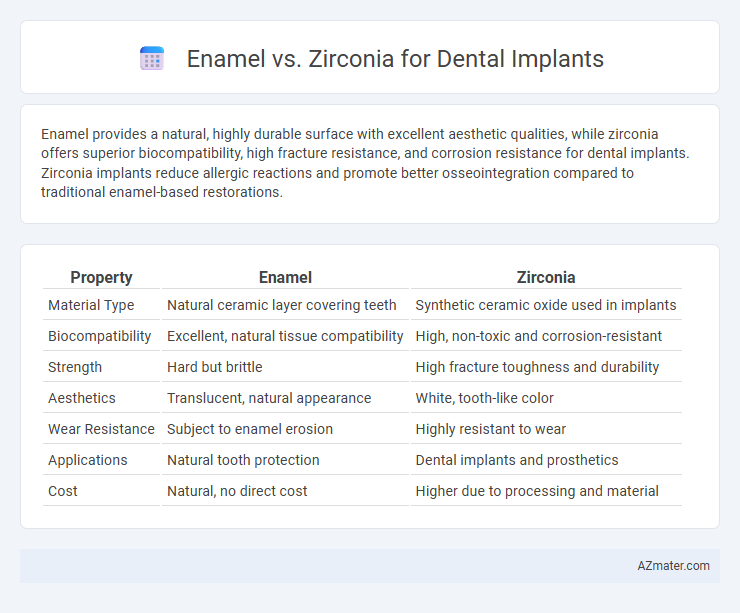Enamel provides a natural, highly durable surface with excellent aesthetic qualities, while zirconia offers superior biocompatibility, high fracture resistance, and corrosion resistance for dental implants. Zirconia implants reduce allergic reactions and promote better osseointegration compared to traditional enamel-based restorations.
Table of Comparison
| Property | Enamel | Zirconia |
|---|---|---|
| Material Type | Natural ceramic layer covering teeth | Synthetic ceramic oxide used in implants |
| Biocompatibility | Excellent, natural tissue compatibility | High, non-toxic and corrosion-resistant |
| Strength | Hard but brittle | High fracture toughness and durability |
| Aesthetics | Translucent, natural appearance | White, tooth-like color |
| Wear Resistance | Subject to enamel erosion | Highly resistant to wear |
| Applications | Natural tooth protection | Dental implants and prosthetics |
| Cost | Natural, no direct cost | Higher due to processing and material |
Introduction to Dental Implant Materials
Dental implant materials primarily include enamel and zirconia, each offering distinct advantages for oral restoration. Enamel-based coatings provide natural aesthetics and biocompatibility, closely mimicking real tooth structure, while zirconia implants offer superior strength, fracture resistance, and low plaque affinity. Advances in material science have positioned zirconia as a popular choice for patients seeking durable, metal-free dental implant solutions with excellent osseointegration properties.
Understanding Enamel and Zirconia
Enamel is the hard, outermost layer of natural teeth, composed primarily of hydroxyapatite crystals, providing durability and protection against decay. Zirconia, a synthetic ceramic material used in dental implants, offers superior biocompatibility, fracture resistance, and aesthetic appeal due to its tooth-like color and translucency. Understanding the distinct properties of enamel and zirconia helps in selecting the optimal material for dental restorations, balancing natural tooth compatibility with long-lasting implant strength.
Physical Properties: Enamel vs Zirconia
Enamel exhibits a hardness of approximately 5 on the Mohs scale, providing natural protection and resilience for teeth, whereas zirconia boasts a much higher hardness around 8, offering superior durability and resistance to wear in dental implants. Enamel's modulus of elasticity ranges between 70-90 GPa, allowing some flexibility under chewing forces, while zirconia's modulus exceeds 200 GPa, resulting in greater rigidity and strength suited for long-lasting implant stability. The fracture toughness of zirconia surpasses enamel significantly, with values typically above 5 MPa*m^0.5 compared to enamel's lower toughness, making zirconia less prone to cracking under high stress conditions in oral environments.
Aesthetic Considerations in Implant Choice
Enamel-based materials for dental implants offer superior translucency and natural color gradients closely mimicking real teeth, making them highly desirable for anterior restorations where aesthetics are paramount. Zirconia implants provide excellent biocompatibility and strength with a white, opaque appearance that resists staining but can appear less lifelike compared to enamel in terms of depth and light transmission. Selecting between enamel and zirconia hinges on balancing aesthetic demands with structural integrity and long-term color stability in the implant area.
Durability and Longevity Comparison
Zirconia dental implants offer superior durability and longevity compared to enamel, as zirconia is a highly resistant ceramic material that can withstand significant chewing forces without fracturing. Unlike natural enamel, which can wear down and become prone to decay over time, zirconia implants maintain structural integrity and resist corrosion and bacterial buildup. Clinical studies show zirconia implants have a longer lifespan and lower failure rates, making them a preferred choice for long-term dental restoration.
Biocompatibility and Safety
Zirconia implants exhibit superior biocompatibility and safety compared to enamel due to their resistance to corrosion and minimal allergenic potential, reducing inflammation risks. Enamel, while naturally biocompatible as a tooth's outer layer, is not used as an implant material due to its brittleness and inability to integrate with bone tissue. Zirconia's osteointegration properties and hypoallergenic nature make it a preferred choice for dental implants in patients with metal sensitivities.
Resistance to Wear and Staining
Zirconia dental implants demonstrate superior resistance to wear and staining compared to enamel, making them a preferred choice for long-term durability. Enamel, while naturally strong, is more susceptible to erosion and discoloration from acidic foods and beverages. The dense, non-porous structure of zirconia prevents staining and maintains its aesthetic appearance even under heavy use.
Cost Differences: Enamel and Zirconia
Zirconia dental implants typically cost more than enamel-based options due to advanced material properties and manufacturing processes. Enamel implants, often made from composite materials, offer a more affordable alternative with adequate durability for certain patients. The price difference reflects zirconia's superior biocompatibility, strength, and aesthetic appeal, which contribute to longer-lasting dental restoration outcomes.
Clinical Applications and Suitability
Zirconia dental implants offer superior biocompatibility and durability, making them highly suitable for patients with metal sensitivities or allergies, whereas enamel-like coatings on implants aim to enhance osseointegration and aesthetic outcomes. Zirconia's high fracture resistance and low plaque affinity make it ideal for clinical applications in both anterior and posterior regions, supporting long-term success rates. Enamel-mimicking materials, though less common, provide improved surface hardness and wear resistance but are primarily limited to restorative components rather than full implants.
Choosing the Right Material for Your Implant
Zirconia offers superior strength and biocompatibility compared to enamel, making it a preferred choice for dental implants due to its resistance to fractures and reduced risk of allergic reactions. Enamel, being the natural outer layer of teeth, is not suitable as an implant material but is crucial for the aesthetic restoration on top of implants. Selecting zirconia ensures durability and longevity in dental implants, while enamel is important for the natural tooth-like appearance and protection of the implant crown.

Infographic: Enamel vs Zirconia for Dental Implant
 azmater.com
azmater.com